
You will find this stocky, multicolored fish cruising many of Hawaii’s reefs, pushing itself around using the fins on its back and belly. Its body is shaped almost like a parallelogram with a blue mustache, a blue and black striped cap, and a fan-shaped tail attached by a dark sideways “V” outlined in gold (the wedge). These fish are usually shy, but if guarding a nest, they have been known to bite
snorkelers. Their magnificent Hawaiian name – a tongue-twister for many non-native speakers – has elements meaning “to stitch pieces together” and “nose like a pig.” When stressed, these fish can make a pig-like sound. The idea of stitching may speak to their various colors and shapes. Not an endemic species, the wedgetail triggerfish became the Hawaii state fish waaaaaay back in 1985 – by popular vote!
Longnose Butterflyfish - Hawaii Fish
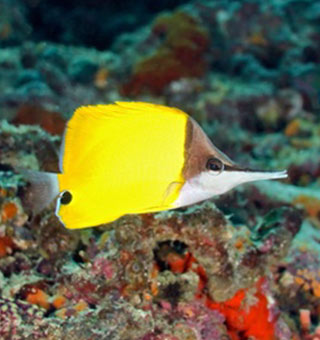
Easy to spot on the reef, the longnose butterflyfish is mostly bright yellow, with a black bandit’s mask, white chin, a black spot beneath the tail, and of course – a very long nose! These fish come in two “flavors”: Common, which bite off bits of creatures like sea stars for food; and Big, which eat small shrimp. The longnose butterflyfish has a long nose along with the longest known fish name in the Hawaiian language! It’s called the lauwiliwilinukunukuoi’oi. (Try saying that through your
snorkel!)

Raccoon butterflyfish are so named for their black, raccoon-like masks. Mostly orange-yellow, they have a white headband, dark stripes that run diagonally along their sides, and a wide black stripe outlined in yellow that looks a little like a scarf thrown up over their shoulders. These fish usually cruise the reef coupled up or in large schools, but they can be seen alone. These guys eat spineless marine organisms like worms, sea anemones, and other things that humans think are gross and slimy but are actually really interesting when you take a closer look.
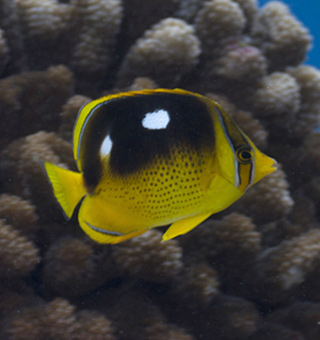
The four spot butterflyfish has – you guessed it, you smart swimmer, you! – four spots. (That’s two white spots on either side, actually.) To imagine what this species looks like, draw a not-so-straight line across the center of their body from nose to tail. Color in dark brown above the line (this is where the spots are), and put yellow-orange below. Make the nose and head yellow, and place a dark brown and yellow stripe through the eye. Four spot butterflyfish sustain long-term, monogamous relationships. Their favorite food – and the one they eat the most – is cauliflower and broccoli together. Just kidding – broccoli doesn’t grow in the ocean, but cauliflower coral polyps do! Yum, yum!

There are more milletseed butterflyfish on coral reefs than any other butterflyfish species. This fish is bright yellow with columns of black spots like champagne bubbles moving up the fish’s sides (or like milletseeds, hence the name). These guys also have a dark stripe masking their eyes. Milletseeds are omnivores and quite entrepreneurial. They have been seen manning (fishing. . .?) their own cleaning stations, where they pick parasites from unhappy hosts. This service fills the butterflyfish’s belly, and the clean customers leave with a smile! (We assume. Do fish smile? Do you smile? There ya go! Faaaaantastic!)
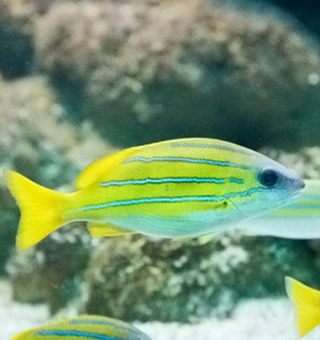
Bluestripe snapper are mainly yellow, with four thin blue stripes than run head to tail. Like the peacock grouper, this fish was introduced to Hawaii in the 1950s to supplement the natural game fish, but the snapper (also called “ta’ape”) are hardly eaten here. The bluestripe themselves are predators, eating fish, crabs, shrimp, and other organisms. You will de”fin”itley see large schools if you go out with the
Atlantis Submarine tour to check out the ship-reef. One group I saw down there was so big, I stopped counting after a while!
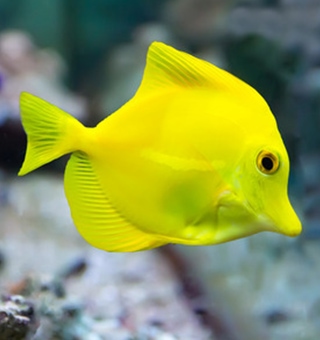
Yellow tang are the fish you’ll see the most on brochures advertising snorkeling. (I threw you off there for a second, didn’t I?) Utterly yellow except for white spines jutting from the base of the tail, these disc-shaped fish often travel in large schools, creating huge patches of color that can sometimes be seen from shore. Yellow tangs often clean the shells of Hawaiian green sea turtles, but they have never been seen to wax them. It has been proven that yellow tangs can live to be at least 70 years old. Can you believe that?
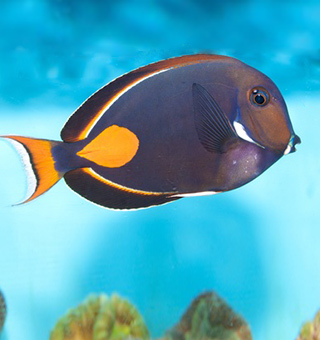
According to John P. Hoover, fish identifier extraordinaire, Achilles Tangs are named after “the Greek warrior Achilles, who symbolizes youthful grace, beauty, and valor.” Easily found cropping algae, these beautiful fish are larger than many living on the reef. They are primarily dark colored, and they sport a distinctive bright orange teardrop patch just before the base of their tail. A wide orange bar also runs along the tail itself. Achilles tangs like to hang out right where waves spill over into the shallow reefs – an area known as the surge zone.
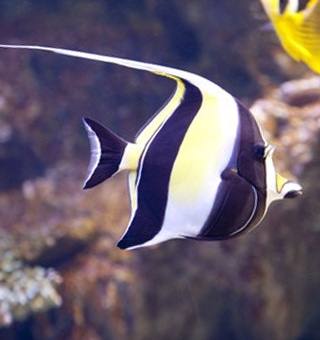
Moorish idols, with their wide vertical yellow, white, and black stripes, tapered nose, and tall thin dorsal fin, are one of the most recognizable fish on the reef. This species has even become famous on the big screen! One moorish idol you may be familiar with is Frank, the tough leader of the aquarium residents voiced by Willem Dafoe in the film “Finding Nemo.” (Just an FYI, real live moorish idols don’t do well in tanks, either.) Moorish idols can grow fairly large, attaining a length of over eight inches – and that on a primary diet of sponges. Pretty awesome, right?
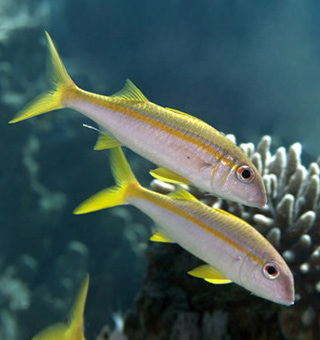
Yellowfin goatfish hang out in huge schools all day long, resting. Although they have a horizontal yellow stripe running along their length and yellow fins, they sometimes look almost transparent. You may not see them until you’ve snorkeled very close. At night, these goatfish eat small organisms that live in the sand. Using the strong yet sensitive barbels attached to their chins, goatfish rummage through the top layers, searching for prey. “Weke, ” part of this fish’s Hawaiian name, means “to open.” When an individual needed to experience a spiritual opening in ancient Hawaii, healers used goatfish in the religious ceremony.
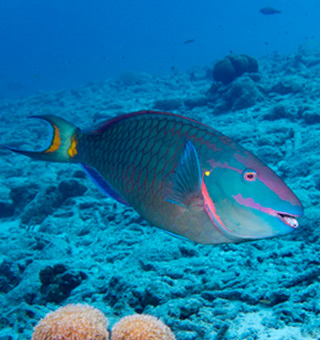
Although they have a lot of competition, parrotfish are probably on the Top 10 List for the “most interesting fish on the reef.” First of all, these fish are beautiful, especially when they are in their bright blue male phase. Males of this species keep a harem of females, and when the male dies, the alpha female of the harem switches sex, becoming a male herself. When I see parrotfish on the reef, I always get quiet and hold my snorkel breath for a few seconds. That way, I am sure to hear the rasping sound that the fish’s strong beak makes when it chomps on coral while eating the algae growing there. The hard, indigestible parts these fish also take in soon become white coral beach sand. Yep, that’s some of what’s between your toes right now.

These fish are often mistaken for moorish idols when they are first sighted underwater. Although their colors are similar, you’ll notice differences between them – especially if you happen to catch a glimpse of the two species side-by-side. The pennant butterflyfish has a white body with two wide black vertical stripes, a yellow tail and dorsal fin, and another tall dorsal fin that trails like a pennant. If you pick up on subtleties, you’ll see that the fish move differently, too: idols seem to drift, while pennants seem to flit. Although they usually spend their time about 40 feet down, all you need to do to see them at
Molokini Crater is put your face in the water. Pennant butterflyfish are just below the surface.
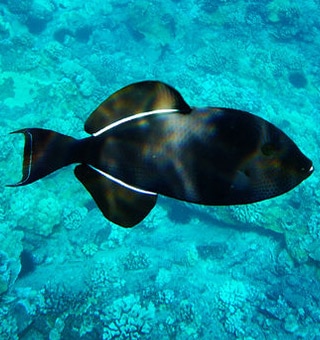
The black triggerfish looks simply black at first glance, but get closer and you are in for a wonderful surprise! There are gorgeous blue and green lines that radiate from their eyes at times, and if the fish turns sideways and you can see it catch the sunlight, the beauty and wonder of it will take your breath away! A neon blue line that looks like really cool caulking appears to attach their dorsal and caudal fins to the length of their bodies. As they swim, these football-shaped fish toss these fins with flair, as a flamenco dancer does her skirt. (When you see them, you’ll know what I mean.) Black triggerfish, also known as black durgon, are often found just below the surface at Molokini Crater and Kahekili (Airport) Beach Park. They consume algae, plankton, and fish eggs.

This energetic fish swoops just above the surface of the reef, flapping its pectoral fins rapidly to dive and turn all over the place. You’ll see one, maybe recognize it, and then it will be gone. And then it will come back. And shortly it will be gone again, possibly to hunt for small invertebrates. The saddleback wrasse is so named for the orange saddle that wraps like a turtleneck between the fish’s blue head and green body. When they are young, these fish are white with a black horizontal stripe down the middle. If an adult grows up to be smaller in size, it has a major advantage: it can switch to its younger coloration at will so as to not be bothered by large adults. Who knew that fish ever lied about their age?

Trumpetfish are one of the oddest-looking fish on the reef, at least by human standards. Long and thin when viewed from above, long and wide when seen from the side, and almost invisible when encountered face-to-face, these fish are superb hunters. They propel themselves slowly with fins located on the back of their body, and those are the only parts that move – besides their eyes, I surmise. I wouldn’t call them masters of camouflage like the octopus, but they can change color and add vertical or horizontal stripes to blend in with their surrounding environment or nearby fish. Trumpetfish, which are normally gray but can become bright yellow or olive green, are super patient. They’ll hang in the water, quietly stalking, waiting for that perfect moment to open their mouth and bring in fish food. (A fish for food, that is!)

The Hawaiian cleaner wrasse, like many locals, lives exclusively in the Islands. These small fish are tri-colored, with a black horizontal mark that starts out thin but gradually enlarges until it almost covers the tail end of the fish. From stem to stern, the colors move from bright yellow to purple to magenta. Cleaner wrasses set up shop at a specific spot on the reef. When the wrasse’s shop is open, the fish bobs up and down to signal that their service station is ready. While cleaning customers of mucus, dead tissue, and occasionally parasites, these fish trail their fins along their customers’ sides. It has been shown that reef fish instinctively pose to be cleaned; the odd positioning is not something they learn over time.
Hawaiian Green Sea Turtle (Honu)

The Hawaiian green sea turtle is an iconic living symbol of the Islands. While sea turtles generally swim at a slow pace, they can dash off extremely fast when they want to! These guys are also super strong, and they can weigh up to 400 lbs/181 kilos. Sea turtles are reptiles, and they breathe air at the surface. These turtles come up to breathe every few minutes when they are busy. At rest, they can stay below for up to two hours. When you see one – and if you go snorkeling in Hawaii, there is a very good chance that you will! – please respect this protected species. While you enjoy sharing space with such a graceful animal, never touch a honu, give them room to breathe, and let them swim whichever way they want to go. Thirty feet away is a safe rule of thumb – it keeps all species feeling on vacation.
Hawksbill Sea Turtle (Honu'ea)
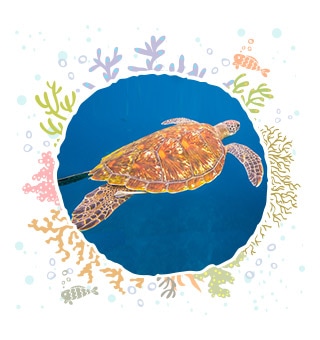
Hawksbill sea turtles have a narrow, sharp-looking beak, like a hawk’s. The “tiles” that make up their shell overlap each other slightly. This overlapping does not occur in our more common Hawaiian green sea turtle. If you see an endangered hawksbill while snorkeling, it is an occasion worth celebrating, because this turtle is quite rare in Hawaii. However, do not celebrate by releasing balloons, please. Deflated balloons are just one reason sea turtles have such problems near humans – they eat floating balloons that seem to be jellyfish, and afterwards they cannot dive or eat again, sometimes choke, and always die. Hawksbill turtles eat sponges as well as other invertebrates that live on the rocks. Most hawksbill nesting sites are in the main Hawaiian islands, and these areas are vulnerable (or already gone) due to the development of beachfront properties. If you are walking along the beach, and you see a turtle nest that’s been roped off, keep dogs away from it and feel free to celebrate even more! Totally cute turtle babies may be hatching soon!
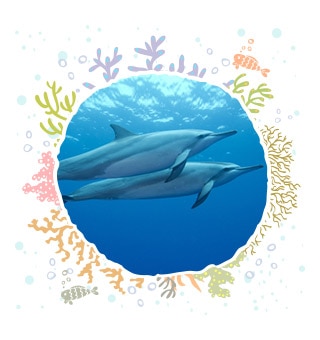
Spinner dolphins are extremely social, intelligent, and beautiful animals. They live in large groups called pods, resting together throughout the day and cooperatively hunting and feeding together at night. Spinners eat fish and squid, and no one knows exactly why they spin they way they do. There are many theories, including a) they do it for fun, b) the spinning is a form of communication, and c) the dolphins spin to shake off parasites or remoras. These dolphins are smaller and more slender than many other species, attaining an adult length of about 7 feet. A spinner’s body coloration, called countershading, protects them from predators and hides them from prey. The back of the dolphin is dark grey, the middle is a softer, lighter grey, and the lower third is a shade lighter than that. When someone looks at a dolphin from above, the dolphin’s dark grey back blends in with the deep blue sea below. On the other flipper, when you see a spinner from below, their light grey belly blends in with the sunlight streaming in from above. Do not approach, try to swim with, or touch spinners in the water – they need their rest just as much as we do, if not more. (When was the last time you spent 24 hours in the ocean? They do it all day, every day!) Your marine mammal respect is greatly appreciated. Thank you!
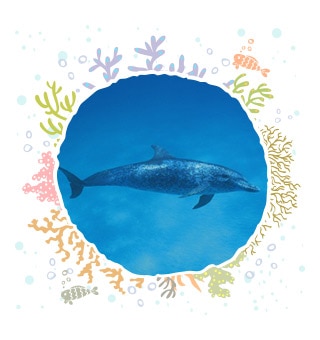
Spotted dolphins are sleek and powerful marine mammals. Stenella attenuata are actually born spot-less, “collecting” spots all over their body as they mature. When it comes to color, they are mostly grey, but have a dark grey “cape” draped over their backs (think underwater Batman). Their beaks are tipped with white, as if each dolphin once dipped tentatively into a tiny cup of milk. Speaking of milk, calves may nurse for up to two years, but they start eating solid food at around four months of age. Spotted dolphins enjoy eating fish and squid, leaping from the water, diving back into the water, and long walks on the beach. (Just kidding. A beached dolphin is not a good thing.) Spotted dolphins who live in the Atlantic Ocean are the species hardest hit by the tuna trade, partially because they gather in such huge pods – sometimes up to 1000 individuals at a time! In Hawaii, these dolphins are generally found farther offshore than their cousins, the spinners.
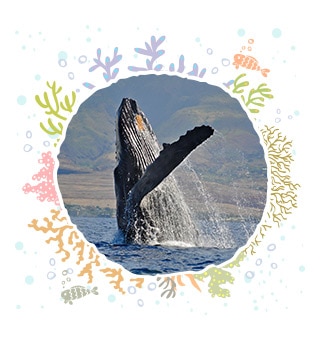
Humpback whales are one of the most incredible animals swimming in the ocean. Humpbacks can grow up to 50 feet long, and adult females can weigh up to 50 tons. At birth, calves can weigh up to two tons and be as long as an SUV! These whales migrate thousands of miles every year, in almost a completely straight line. As they must handle oceanic currents, weather, and obstacles throughout their six week voyage, that is no small feat! (Just so you know, there is no whale GPS, at least not the kind we’re used to.) The males sing wonderful complex songs each breeding season that are very hard to imitate. (You ought to try it, though.) If you’re visiting Hawaii between mid-December and mid-April,
go on a whale watch. It’s one of the best uses of your time here. And also, if you’re here during whale season, stick your head underwater. You can often hear the whales singing! (Sorry, I don’t think the hotel pool counts, hee hee!)
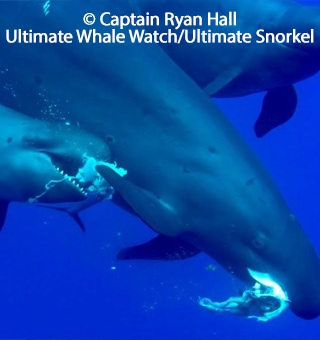
Despite the fact that there is a resident population living around the main Hawaiian Islands, false killer whales, or pseudorcas, are rarely encountered by people. These deepwater members of the dolphin family are black and torpedo shaped with a curved dorsal fin and no beak. Their skulls are very similar to that of the killer whale, and that’s why they’re called pseudorca. False killers are a gregarious, long-lived, social species who eat mostly fish and squid. Marine biologist Robin Baird has been studying their biology and behavior in the Islands since 2000. He’s seen a pod catch a fish and then pass it around to one another – without any of them taking one bite! False killer whales have also offered freshly caught fish to people – whaaaat?!1 Keep your flippers crossed that you’ll see a member of the endangered Hawaiian population while you’re out here. If you do see one and get some good shots of it, make note of the date, time, and location, and send them to Robin Baird. It takes a village to study false killers!
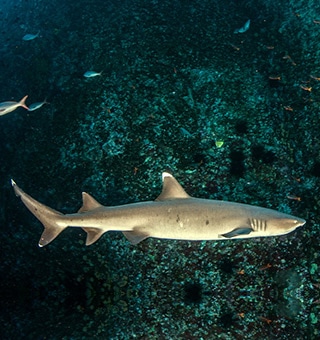
You can sometimes find these small gray sharks resting on the bottom, usually hidden beneath a ledge. These beautiful six to seven foot sharks have white tips on their dorsal and tail fins. They are nocturnal hunters, so if you see one swim by while you’re snorkeling, it’s kind of like when you wake up in the middle of the night to use the bathroom – they’re not quite awake. Just enjoy watching as they pass.
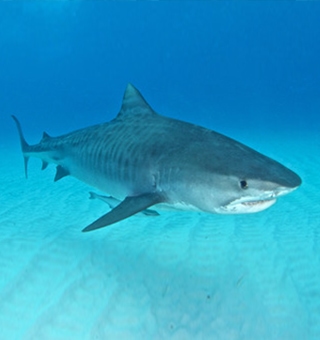
These hefty-bodied sharks can grow up to 15 feet long. Their stomachs have been found to contain sea turtles, monk seals, albatross, fish, and lobsters, as well as explosives, beer bottles, and anchors. (Did you know some sharks can
push their stomachs out of their bodies to rinse out what they can’t digest?) Shark vision is not great in murky water, so swimming in murky water is not a great plan.
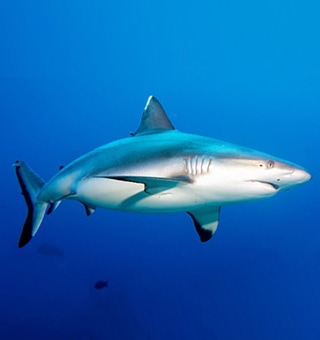
Awfully pretty with sharp, clean lines, the gray reef shark is a slender, quick-moving predator that can reach up to eight feet long. Dinner is often fish. (Aw, Mom, fish again?) Gray reef sharks usually ignore people in the water, but they will attack if they feel threatened, so do not corner one or chase after it with your GoPro. If you are lucky enough to see one, keep facing it and swim backwards slowly. Also, you can try tossing your wallet at the shark.
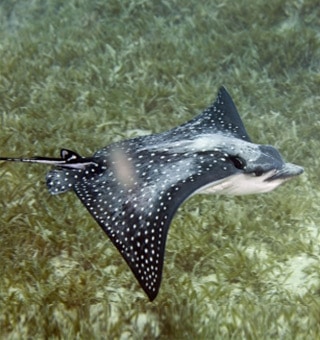
This is one of the most beautiful animals beneath the surface. They sometimes fly in groups, gliding over the reefs with an occasional flap of their strong, fleshy wings. The body is dark on top with hundreds of small white spots. The belly is completely white. Their long tail has spines near the base. While snorkeling, I once encountered a spotted eagle ray in a strong current. I struggled to stay beside him, and though I did not see him move a muscle, he somehow stayed in one spot! Spotted eagle rays eat mollusks from the sandy bottom.
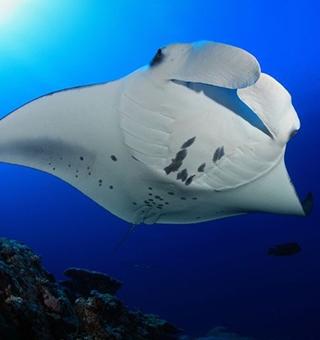
These large, intelligent animals eat exclusively plankton. The manta ray’s wingspan can reach over 12 feet! From birth, each individual has its own unique pattern of color, with most of the dark on the dorsal surface (back), and most of the light on the ventral surface (belly). A manta’s home range encompasses just a few miles. About ten percent of Maui’s mantas have been tangled in fishing line, which – among other damage – can cut off their flexible cephalic fins used for waving plankton into their mouths. You can see Big Island mantas on an
evening snorkel tour off Kona.

This eel’s body is mainly white, and it has a series of blobs like a
Rorschach test along its sides. (I think the splotches either look like the cell bodies and dendrites of a neuron, or like happy trees dancing. So what does that say about me?) Eels move like snakes underwater, undulating their muscular bodies back and forth. The snowflake eel hunts for invertebrates during the day, but many other eels rest in their lairs during prime snorkel time, so don’t touch the reef. Poking your fingers into the den of an eel can lead to a nasty bite!
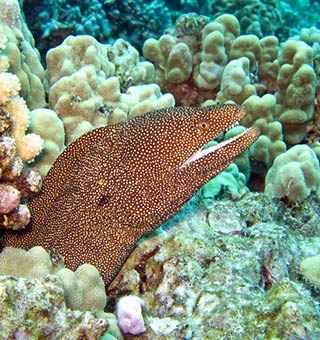
These white-speckled eels have brown bodies, and they often hold their bright white mouths open wide. They hunt during the day, so you may spot one while you’re snorkeling on the surface! Whitemouth morays will often join a hunting party of jacks or goatfish. The eel will dive into holes in the reef to flush out prey, while its fish partners wait above to stop the food from getting away. The Hawaiian word for eel in general is “puhi.” This same word is used for a Hawaiian Lomi Lomi massage technique that mimics the movement of an eel along the client’s lower back.

Hawaiian day octopuses are light brown and tan, with a maximum arm span of about three feet. They dine on crustaceans and bivalves (pretty much anything with a hard shell on the outside). An octopus is one of the most interesting and intelligent animals on the reef! One of its superpowers is “invisibility.” A hiding octopus will camouflage itself by imitating the color
and the texture of its surroundings! If you are lucky enough to see one move, keep your eyes glued to it, stay still so that it does not become frightened, and motion for your
snorkel buddy.

These strong and flexible eight-legged cephalopods can be seen hunting at night for crustaceans, fish, and other species of octopus. White striped octopus are mainly red or pink with white stripes that run from the tip of their “nose” to the back of their head – the area called the mantle. Octopuses have three hearts and a supremely well-connected nervous system that is distributed throughout their entire body –
60% of which is in its arms alone! Ancient Hawaiians hunted these animals by finding them on reef flats with torches. The octopuses weren’t the ones carrying the torches. . .
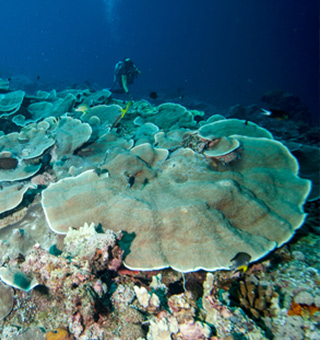
Rice coral fashions itself into all kinds of shapes, including “fingers” reaching toward the surface, branches, and tiered plates. The surrounding environment plays a part in molding the shapes the colony will take: how can the algae living in the outer tissues gather the most sunlight through the surface? This stationary group of animals is populated by clones of a single founding ancestor, which is called a polyp. Polyps build coral from the inside out, and live inside the coral structure they have built. Awesome, rice? I mean. . .right?
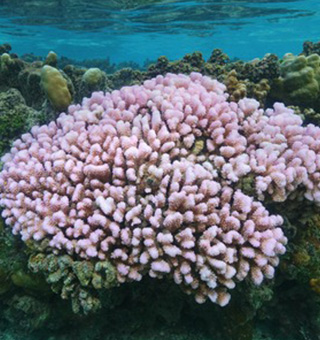
One of the more common corals you’ll spot on shallow reefs, cauliflower coral looks like its vegetable namesake. I do not know how this coral tastes, but the four spot butterflyfish sure loves eating the polyps! A polyp is the animal architect that builds all corals from within. Coral polyps survive by snagging plankton cruising by, and by partnering with photosynthetic algae living in the coral’s outer tissues.
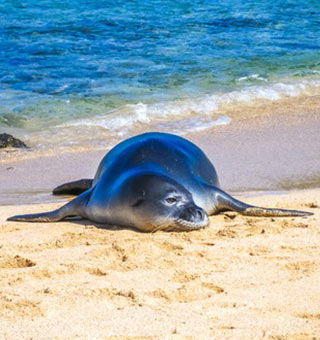
The Hawaiian monk seal, a highly endangered marine mammal, is native to the Islands. Monk seals are the oldest seal species on Earth, and they are called “monk” because they generally swim solo. They eat fish, squid, eels, and octopuses. You may see one sleeping on a beach or in an underwater cave. If you encounter a Hawaiian monk seal, it’s a big deal! Leave it alone, and call it in at (808)292-2372. As of this writing (August 2016), most of the 1200 in the population are found in the
Northwestern Hawaiian Islands. Thanks to U.S. President Obama, that region of the Pacific – the
Papahanaumokuakea Marine National Monument – just became the largest permanent marine protected area in the world to date! PMNM grew from 139,800 square miles to 582,578! (Of course, being one-upped in a conservation situation like this would be a good thing.) The more ocean space we can protect, the more marine life will thrive – Hawaiian monk seals included.











































